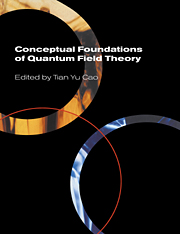Book contents
- Frontmatter
- Contents
- List of contributors
- Preface
- Photographs of the conference
- Introduction: Conceptual issues in quantum field theory
- Part One Philosophers' interest in quantum field theory
- Part Two Three approaches to the foundations of quantum field theory
- Part Three
- Part Four Mathematics, statistics and quantum field theory
- Part Five Quantum field theory and space-time
- Part Six
- Part Seven Renormalization group
- Part Eight Non-Abelian gauge theory
- Part Nine The ontology of particles or fields
- Part Ten
- Name index
- Subject index
Introduction: Conceptual issues in quantum field theory
Published online by Cambridge University Press: 22 September 2009
- Frontmatter
- Contents
- List of contributors
- Preface
- Photographs of the conference
- Introduction: Conceptual issues in quantum field theory
- Part One Philosophers' interest in quantum field theory
- Part Two Three approaches to the foundations of quantum field theory
- Part Three
- Part Four Mathematics, statistics and quantum field theory
- Part Five Quantum field theory and space-time
- Part Six
- Part Seven Renormalization group
- Part Eight Non-Abelian gauge theory
- Part Nine The ontology of particles or fields
- Part Ten
- Name index
- Subject index
Summary
Quantum field theory (QFT) is a powerful language for describing the subatomic constituents of the physical world (quarks, leptons, gauge bosons, Higgs scalars, and so on) and the laws and principles that govern them. Not only has it provided a framework for understanding the hierarchical structure that can be built from these constituents, it has also profoundly influenced the development of contemporary cosmology and deeply penetrated into the current conception and imagination of the origin and evolution of the universe. For this reason, it has justifiably long been taken to be the foundation of fundamental physics: elementary particle physics and cosmology.
QFT reached its most spectacular success in the early 1970s in the standard model, which is able to describe the fundamental interactions of nature within a unified theoretical structure: the non-Abelian gauge theory. Ironically enough, however, this success brought about a long period of stagnation in its conceptual development: virtually nothing of physical importance occurred after the construction of the standard model except for its detailed experimental verification. This situation can be assessed in different ways, depending on what perspective we start with. For example, the stagnation could be taken to be an indication that the theoretical development of fundamental physics has come to an end.
- Type
- Chapter
- Information
- Conceptual Foundations of Quantum Field Theory , pp. 1 - 27Publisher: Cambridge University PressPrint publication year: 1999
- 10
- Cited by

